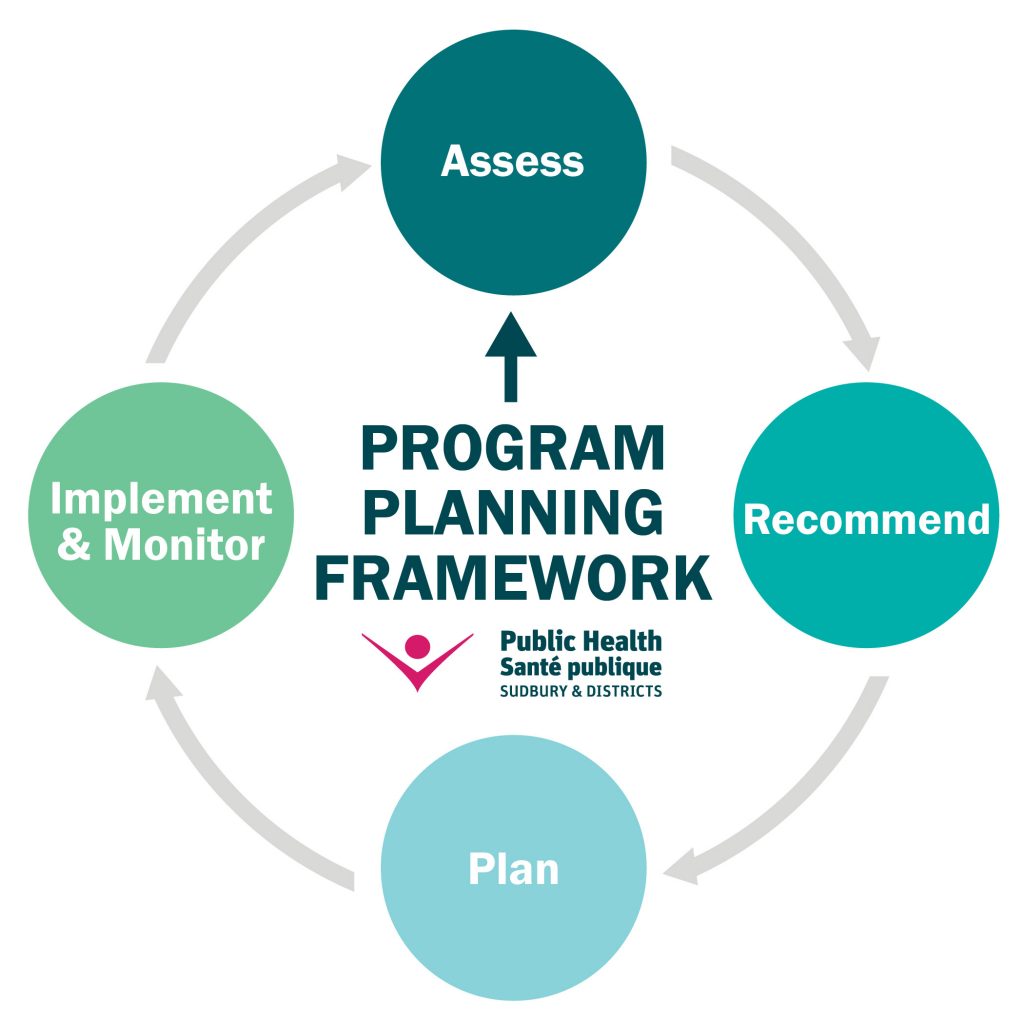Public Health Sudbury & Districts Program Planning Framework
Public Health Sudbury & Districts Program Planning Framework (PDF, 921 KB)
It’s a Guide
The planning framework is a standard framework to guide the assessment, planning, implementation, and evaluation of our work in public health.
It’s Flexible
Tools exist within the cycle to assist you with planning. These tools include the following:
- Evidence Repository Form
- Evidence Synthesis Form
- Logic Model
- Activity Planning Template
- Evaluation Plan
- Prompts for Decision Making
Who is Responsible?
Program managers are the leads for planning. They are supported by key staff.
Deliverables
Evidence Synthesis
A synthesis of evidence should include a summary of all varieties of evidence for local needs and interventions. Forms include recommendations based on need, impact, capacity and partnerships including how programs of public health interventions should be continued (i.e. status quo, reframe/reorient, new work, or stop work). Updates to the Evidence Synthesis Forms are required annually.
Activity Plan
Activity plans should include all prompted programming details. Updates are expected mid-year and at year-end.
Logic Models
Logic models should be broad and high-level. Models should include information about monitoring and evaluation. Updates to the models are required annually.
Activity Plan
Activity plans should include all prompted programming details. Updates are expected mid-year and at year-end.
Evaluation Plan
Evaluation and monitoring can impact future priorities and programming activities. Sufficient time and resources should be allocated to this critical part of the cycle.
Public Health Sudbury & Districts Program Planning Framework
1. Assess
- Define the issue or problem
- Learn how to define your issue/problem with the Evidence-informed Public Health video
- Complete deliverables
- Evidence Repository Form (all year long)
- Use the Evidence Repository Form as a fulsome assessment and summary of evidence for local needs and interventions, including gaps in evidence, and your recommendations as planners and decisions as managers.
- Considerations for district offices should be included
- Identify target and priority populations
- Consider valuable evidence from a variety of sources:
- Community health and local context
- Existing public health resources
- Community and political climate
- Population health data
- Best available research findings
- Evaluation data from previous cycle
- Incorporate community engagement strategies
- Consult with collaborating managers/teams
- Evidence Synthesis Form for Need
- Synthesize evidence from all sources and draw conclusions
- Evidence Repository Form (all year long)
Refer to the Prompts for Decision Making tool for extra guidance.
2. Recommend
- Complete deliverables
- Evidence Synthesis Form for Interventions
- Synthesize the evidence and draw conclusions; recommend interventions based on need, impact, capacity and partnerships
- Rely on public health expertise to integrate all relevant factors into any decision making
- Set priorities and make program decisions
- Evidence Synthesis Form for Interventions
3. Plan
- Complete deliverables
- Logic Model
- The model does not have to follow a set template
- Include goal, component, activity, target group, and outcome derived from the evidence collected on the Evidence Repository Form
- Keep each model broad and high-level
- Details regarding activities belong in the activity plans
- Activity Plan
- The Excel template contains all necessary prompts
- Evaluation Plan
- The worksheet is located in the Activity Planning Template
- Submit Annual Service Plans to the Ministry
- Logic Model
4. Implement & Monitor
- Act on the evidence
- Deliver high-quality programs, activities, and services to our community
- Keep track of any barriers to implementation
- Assess the effectiveness of your implementation efforts
- Determine what program and/or intervention modifications should be made
- Conduct ongoing monitoring for a variety of activities to inform
future programming- Help is available through the Evidence-Informed Practice Work Group (EIPWG) and Knowledge and Strategic Services for evaluation activities
- Report on progress as required (e.g. mid-year, year-end)
- Consider evaluating one activity per program, per planning cycle
- Compile any gaps, practice-based questions, and research priorities
- Forward any practice-based questions to EIPWG
This item was last modified on June 22, 2020
